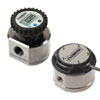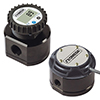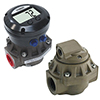Technology Overview

Rotor rotational velocity is directly proportional to flow rate, since the flow of fluid is causing the rotation.
In electronic flow meters the rotating components contain magnets that activate various sensor options located outside the fluid chamber. Mechanical flow meters rely on the rotation to drive either a magnetic coupling or a direct gear train connected to the mechanical counter.
Accuracy

Another benefit is the flow meters ability to process a huge range of viscosities and it is not uncommon to experience higher levels of accuracy while processing high viscosity fluids, simply due to the reduction of by-pass. When considering and comparing flow meter accuracy, it is important to be aware of both ‘linearity’ i.e. the flow meters ability to accurately measure over the complete turndown ratio, and ‘repeatability’, the ability to remain accurate over a number to cycles. This is another area where PD flow meters excel, repeatability of 0.02% and 0.5% linearity are standard.
Reliability
If the correct flow meter has been selected for an application it can be expected to perform without error for many years. Frequently meters are sent in for servicing and recalibration that have been in the field for 10 sometimes 20 years continuous use. This reliability is largely due to the fact that this same proven technology has been in use for over 60 years, allowing the major advances to be focused within the fields of tribology and achieving the required precision at a reasonable cost.
Low Maintenance


Benefits Summary
- High level of accuracy (0.5% as standard) higher level of accuracy available upon request
- Ability to process a large range of fluid viscosities <1 cP – >500000 cP
- Low maintenance
- High pressure capabilities
- Electronic and mechanical versions available
- Spare parts availability
Limitations and Considerations
While PD flow meters are very robust, there are limitations to their usage. Firstly they should not be used for fluids that contain large particles, unless these can be filtered out prior to the fluid entering the measuring chamber. They are also not suitable for applications where large pockets of air are present within the fluid; however air eliminators are available for these applications. Another factor that requires consideration is the pressure drop caused by the PD flow meter; although these are minimal they should also be allowed for in system calculations. As mentioned above when processing fluids with poor lubricating properties, it is recommended that advice is sought from your distributor; various material options are available for these applications.










